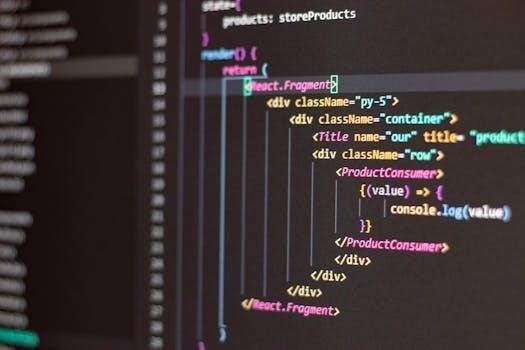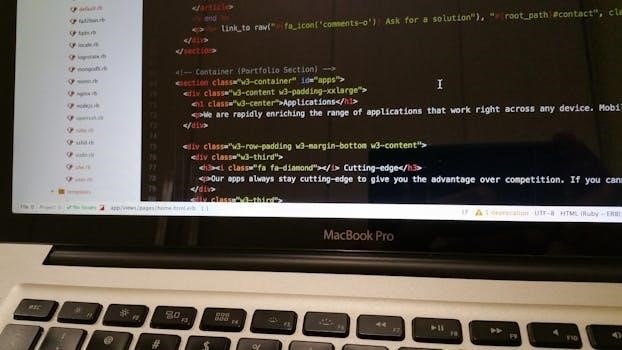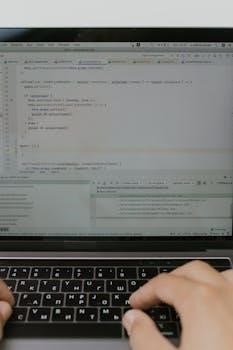html and css book pdf
HTML and CSS Book PDF⁚ A Comprehensive Guide
Embark on your web development journey with our comprehensive guide to HTML and CSS books in PDF format. This curated collection offers valuable resources for beginners and experienced coders alike. Empower yourself with essential knowledge and skills to excel in web design.
HTML (Hypertext Markup Language) and CSS (Cascading Style Sheets) are the foundational technologies for building websites. HTML provides the structure and content of a webpage, while CSS controls its visual presentation. Understanding these languages is crucial for anyone venturing into web development.
HTML uses tags to define elements such as headings, paragraphs, images, and links. These elements create the basic skeleton of a webpage. CSS, on the other hand, allows you to style these elements with properties like colors, fonts, and layouts; By separating content from presentation, CSS enables you to create visually appealing and consistent websites.
Many free HTML and CSS books are available in PDF format, offering a great way to learn these technologies. These books cover topics from basic syntax to advanced techniques. Some books focus on responsive design, ensuring your websites look good on all devices. Others delve into CSS frameworks, providing pre-built components for faster development. Whether you’re a beginner or an experienced coder, these resources can enhance your skills and knowledge of web development.
HTML Basics⁚ Structure and Elements
HTML forms the backbone of every webpage, providing the structure and organization for content. Understanding its basic elements is essential for any aspiring web developer. An HTML document typically begins with a <!DOCTYPE html> declaration, specifying the HTML version being used. The root element is <html>, which contains two main sections⁚ the <head> and the <body>.
The <head> section contains metadata about the document, such as the title (<title>), character set (<meta charset="UTF-8">), and links to external stylesheets (<link rel="stylesheet" href="style.css">). The <body> section contains the visible content of the webpage, including headings (<h1> to <h6>), paragraphs (<p>), images (<img>), links (<a>), and lists (<ul>, <ol>, <li>).
Elements can have attributes that provide additional information. For example, the <img> tag uses the src attribute to specify the image source and the alt attribute for alternative text. Mastering these basic elements and their attributes is crucial for building well-structured and accessible webpages. Numerous free HTML and CSS books in PDF format offer comprehensive guidance on these fundamentals.
CSS Fundamentals⁚ Styling and Layout
CSS (Cascading Style Sheets) is the language used to style and layout HTML elements. It allows you to control the visual presentation of your webpage, including colors, fonts, spacing, and positioning. CSS rules consist of selectors and declarations. Selectors target specific HTML elements, while declarations specify the styles to be applied. Declarations consist of a property and a value, such as color⁚ blue; or font-size⁚ 16px;.
CSS can be applied in three ways⁚ inline, internal, and external. Inline styles are applied directly to HTML elements using the style attribute. Internal styles are defined within the <style> tag in the <head> section. External styles are defined in separate .css files and linked to the HTML document using the <link> tag.
CSS also provides powerful layout techniques, such as the box model, which defines the structure of elements as rectangular boxes with content, padding, border, and margin. Understanding the box model is essential for controlling the spacing and alignment of elements. Furthermore, CSS offers various positioning schemes, including static, relative, absolute, and fixed, allowing you to precisely position elements on the page. Numerous free HTML and CSS books in PDF format delve into these fundamentals, providing practical examples and exercises to solidify your understanding.
Free HTML and CSS Books in PDF Format
Accessing quality learning resources doesn’t have to break the bank. Numerous free HTML and CSS books are available in PDF format, offering a cost-effective way to enhance your web development skills. These books cover a wide range of topics, from basic HTML structure and CSS styling to advanced layout techniques and responsive design principles. Many of these resources are licensed under Creative Commons, allowing you to freely copy, distribute, and adapt the content for non-commercial purposes.
Whether you’re a complete beginner or an experienced coder looking to brush up on your skills, you’ll find valuable information in these free books. They often include practical examples, step-by-step tutorials, and exercises to help you solidify your understanding of HTML and CSS. Some popular titles include beginner’s guides, complete references, and books focusing on specific aspects of web design, such as responsive design and printing with CSS. By exploring these free resources, you can build a solid foundation in web development and create stunning, user-friendly websites without spending a fortune.
Remember to always check the license terms before using or distributing any copyrighted material.
HTML and CSS⁚ The Complete Reference Book PDF
For those seeking an in-depth and comprehensive understanding of web development, a complete reference book on HTML and CSS in PDF format is an invaluable resource. These books serve as exhaustive guides, covering every aspect of HTML and CSS in meticulous detail. They delve into the nuances of HTML elements, attributes, and structure, as well as the intricacies of CSS selectors, properties, and values.

A complete reference book goes beyond the basics, exploring advanced topics such as responsive design, CSS preprocessors, and accessibility. They often include detailed explanations of browser compatibility issues and best practices for writing clean, maintainable code. These books are designed to be a go-to resource for developers of all skill levels, providing a wealth of information for solving complex problems and mastering web development techniques. Whether you’re building a simple website or a complex web application, a complete reference book can help you navigate the intricacies of HTML and CSS with confidence.
Look for books that are regularly updated to reflect the latest standards and best practices.
Learning Web Design⁚ A Beginner’s Guide
If you’re new to the world of web development, a beginner’s guide to HTML and CSS is the perfect starting point. These books are specifically designed to introduce the fundamental concepts in a clear and accessible manner. They break down complex topics into smaller, manageable chunks, making it easier to grasp the basics of web design. A good beginner’s guide will start with an overview of HTML structure, explaining how to create elements and build the foundation of a webpage.
From there, it will introduce CSS, showing you how to style those elements and control the layout of your page. These guides often include hands-on exercises and step-by-step tutorials to reinforce your learning. They may also cover basic web design principles, such as typography, color theory, and user experience. As you progress through the book, you’ll learn how to create simple websites, format text, add images, and create basic layouts. A beginner’s guide will provide you with a solid foundation upon which to build your web development skills.
Look for books that use clear language and avoid technical jargon.
Responsive Design with HTML5 and CSS3
In today’s mobile-first world, responsive design is essential for creating websites that adapt seamlessly to different screen sizes and devices. HTML5 and CSS3 provide the tools and techniques needed to build responsive websites that deliver an optimal user experience across desktops, tablets, and smartphones. A book on responsive design with HTML5 and CSS3 will teach you how to use media queries to apply different styles based on the screen size or device orientation.
You’ll also learn about flexible grids and fluid images, which allow your content to scale and adapt to different layouts. These books often cover advanced topics such as viewport meta tags, which control how the browser scales your website on mobile devices. They may also delve into CSS frameworks like Bootstrap or Foundation, which provide pre-built components and layouts for creating responsive designs quickly and efficiently. Furthermore, you’ll explore techniques for optimizing images and other assets for different devices, ensuring that your website loads quickly and performs well on all platforms.
By mastering responsive design principles, you can create websites that are accessible and engaging to users on any device.
HTML and CSS for Printing
While HTML and CSS are primarily used for creating web pages, they can also be effectively employed for formatting content for print. Print stylesheets allow you to tailor the appearance of your web content when it’s printed, ensuring a clean and professional look. A book on HTML and CSS for printing will teach you how to create print-specific stylesheets that hide unnecessary elements, adjust fonts and colors, and optimize layouts for paper.
You’ll learn how to use media queries to target print media and apply different styles accordingly. These books often cover techniques for managing page breaks, creating headers and footers, and generating tables of contents. They may also delve into advanced topics such as generating PDF documents directly from HTML and CSS. Furthermore, you’ll explore best practices for optimizing images and other assets for print, ensuring that they appear crisp and clear on paper.

By mastering HTML and CSS for printing, you can create documents that are both visually appealing and easy to read, whether they’re viewed on a screen or printed on paper. This knowledge can be invaluable for creating reports, brochures, and other types of printed materials from web content.
HTML and CSS Frameworks
HTML and CSS frameworks are pre-built libraries of code that provide a foundation for building websites and web applications more quickly and efficiently. These frameworks typically include a grid system, pre-defined styles for common elements, and a set of reusable components. By using a framework, developers can avoid writing repetitive code and focus on the unique aspects of their projects.
Popular frameworks like Bootstrap, Foundation, and Tailwind CSS offer a range of features that simplify the development process. They often include responsive design capabilities, ensuring that websites look good on all devices. Frameworks also provide a consistent look and feel across different browsers and platforms. A book on HTML and CSS frameworks will teach you how to use these tools effectively.
You’ll learn how to install and configure frameworks, customize their styles, and use their components to build complex layouts. These books often provide practical examples and case studies to illustrate the benefits of using frameworks. Furthermore, you’ll explore best practices for choosing the right framework for your project and integrating it into your workflow. By mastering HTML and CSS frameworks, you can significantly speed up your web development process and create high-quality websites with less effort.
Interactive HTML and CSS Learning Resources
Interactive HTML and CSS learning resources offer a dynamic and engaging approach to mastering web development fundamentals. These platforms typically feature hands-on exercises, coding challenges, and real-time feedback, allowing learners to actively participate in the learning process. Unlike traditional books, interactive resources provide an immersive experience that reinforces concepts through practical application.
Websites like Codecademy, freeCodeCamp, and Khan Academy offer comprehensive HTML and CSS courses that cater to various skill levels. These platforms often incorporate gamified elements, such as points, badges, and leaderboards, to motivate learners and track their progress. Interactive tutorials guide users through step-by-step instructions, providing immediate feedback on their code. This iterative approach helps learners identify and correct errors quickly, fostering a deeper understanding of the subject matter.

Moreover, many interactive resources offer projects that simulate real-world scenarios, allowing learners to apply their knowledge to practical problems. These projects provide valuable experience in building websites from scratch and troubleshooting common issues. By engaging with interactive HTML and CSS learning resources, aspiring web developers can acquire the skills and confidence needed to create compelling and functional websites.
Advanced CSS Techniques
Once you’ve grasped the fundamentals of CSS, diving into advanced techniques can significantly elevate your web design skills. These techniques allow for greater control over styling, layout, and responsiveness, enabling you to create sophisticated and visually appealing websites. One key area is mastering CSS preprocessors like Sass or Less. These tools introduce features such as variables, nesting, mixins, and functions, streamlining your CSS code and making it more maintainable.

Another advanced technique involves leveraging CSS animations and transitions to add subtle yet engaging effects to your website. By manipulating properties like opacity, transform, and color, you can create smooth animations that enhance the user experience. Understanding advanced selectors, such as attribute selectors and pseudo-classes, allows you to target specific elements with precision, enabling fine-grained control over styling.
Furthermore, exploring CSS Grid and Flexbox is crucial for creating complex and responsive layouts. These layout modules provide powerful tools for arranging elements on the page, adapting to different screen sizes, and ensuring optimal viewing experiences across devices. By mastering these advanced CSS techniques, you can unlock the full potential of web design and build truly exceptional websites.


